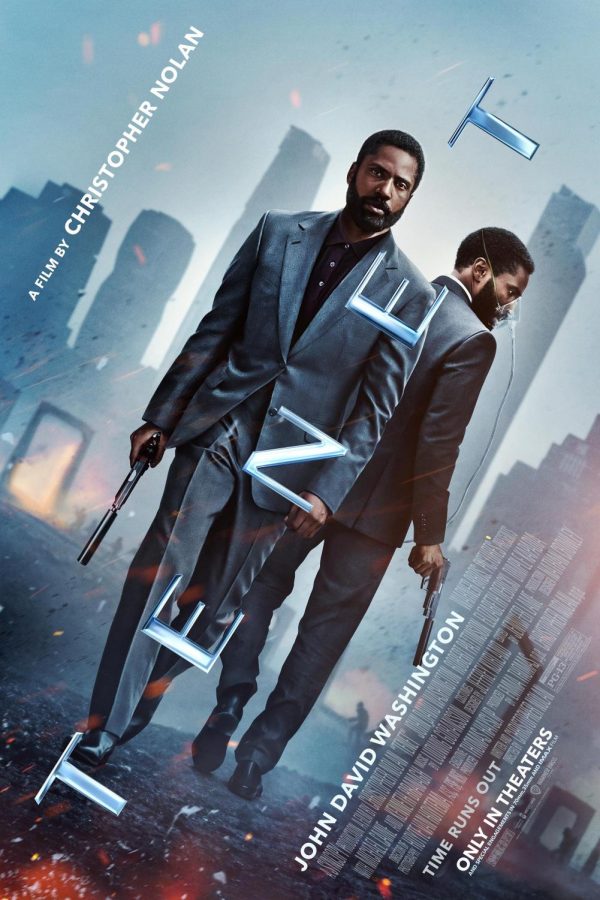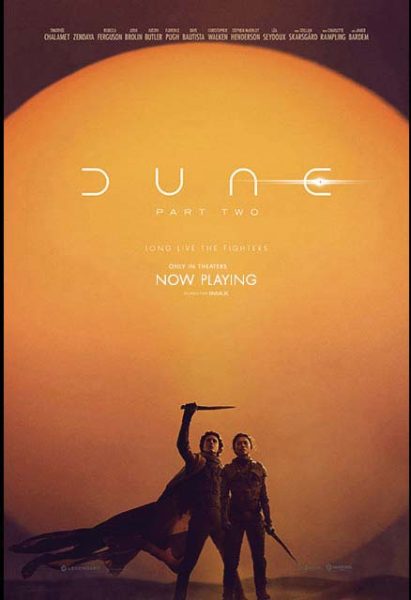“Tenet” review: An ambitious and baffling trip across time
September 7, 2020
Christopher Nolan adds his signature time bending flair to the spy genre for his latest film “Tenet.” The result is a wildly exciting action film, one packed with dazzling style and multilayered substance.
The film follows a CIA agent known as the Protagonist, played by John David Washington. He is recruited by a secret organization called Tenet for a unique assignment. The Protagonist is tasked with preventing Russian arms dealer Andrei Sator, played by Kenneth Branagh, from starting World War III by detonating weapons grade uranium.
The mission involves mastering the complex art of “time inversion,” which is basically a fancy word for time traveling. The Protagonist finds himself aided by Tenet operative Neil, played by Robert Pattinson, and Sator’s estranged wife Kat, played by Elizabeth Debicki. Together, they team up to prevent a global catastrophe that may carry dire consequences across dimensions of time.
The numerous set pieces that surround “Tenet” are a collective thing of beauty. The cinematography from frequent Nolan collaborator Hoyte van Hoytema makes exhaustive use of the places across the world that it portrays. The visually dazzling results give way to endlessly exciting action sequences, skillfully edited together by Jennifer Lame and accompanied by bombastic sound design from Ludwig Göransson.
Speaking of which, Nolan’s previous films have come under fire for poor sound mixing, and “Tenet” is no exception. At times, Göransson’s swelling score completely overwhelms the dialogue, requiring an alert pair of ears to follow along on the film’s story. Nevertheless, it may have been one of many reasons why Nolan wanted “Tenet” to be shown on a big screen. After all, it’s quite an unparalleled cinematic experience, one that keeps up its momentum and wouldn’t let go.
“Tenet” also thrives on the strength of its cast. Washington is magnetic as the Protagonist, and he is in good company with Pattinson, who displays a playful charm reminiscent of Nolan’s previous characters with slicked back hair (see: Leonardo DiCaprio’s Cobb in “Inception”). Debicki, meanwhile, is compelling as a surrogate Hitchcock blonde who refuses to be sidelined. Branagh’s character is a textbook example of a Bond villain, one of many elements that indebted Nolan and “Tenet” to the long running spy franchise.
One of the film’s missteps is that it explains too much. After the sensory experience that is 2017’s “Dunkirk,” Nolan returns to the same trap that has prevented some of his recent films from achieving cinematic greatness. Sure, time travel is a complicated subject even if based on real science. But really, nothing more should be said. As one character earlier in the film conveyed about time inversion: “Don’t understand it, feel it.” In other words, Nolan should take it easy.
Moreover, the film’s consistent current of chaos may alienate those who just wanted to be entertained after staying home for five months. The action sequences may be unbelievably intense in their technical mastery, but Nolan’s cursory attempt at building up emotional stakes ultimately makes “Tenet” a cold one to appreciate.
Nevertheless, it’s no wonder that Nolan consistently pushed for “Tenet” to be seen in theaters. A controversial decision, to be sure, but make no mistake: it’s definitely worth getting out of a self-imposed exile from theaters. Of course, one must take extra precautions when doing so. Either way, Nolan is out to save cinema with an undeniable epic, one that is quite cleverly meant to be seen many times in order to fully appreciate what he has set out to do.
To find showtimes for “Tenet,” click here.




















stzgists • Jan 14, 2021 at 8:45 am
This tenet movie was so confusing the first time I watched it that I had to delete it even my family members were all pissed, but when my friends were talking about it I had to go get it again and watched and understand it. however I later watched another movie lupin and that one I really like and I think that’s the best tv series this year, check my post to see how to Stream or Download it.